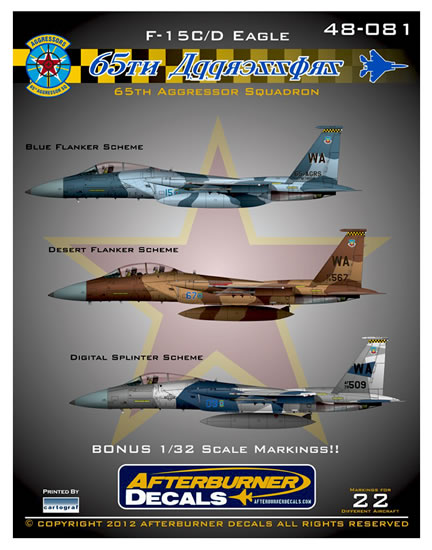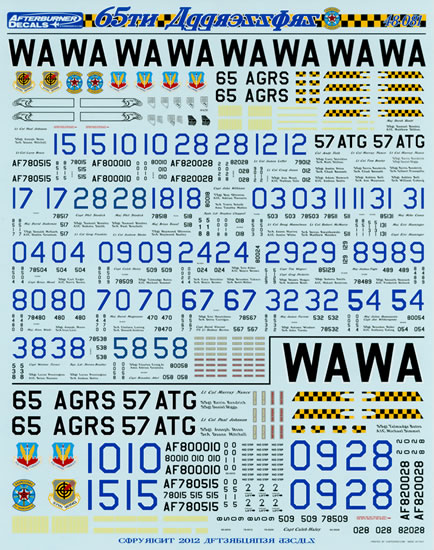F-15 C/D Eagle
65th Aggressor Squadron

Afterburner Decals, 1/48 scale
Summary |
Catalogue Number: |
Afterburner Decals 48-081 - F-15 C/D Eagle 65th Aggressor Squadron |
Scale: |
1/48 |
Contents and Media: |
Waterslide decals plus instructions and notes |
Price: |
USD$20.00
available online from Afterburner Decals |
Review Type: |
FirstLook |
Advantages: |
Perfect register, thinly printed and have an absolute minimum of carrier film surrounding each subject. |
Disadvantages: |
|
Conclusion: |
This is an excellent sheet from Afterburner Decals that combines high quality decals with first rate and complete supporting information. |
Reviewed by Rodger Kelly

HyperScale is proudly supported by Squadron
New from Afterburner Decals is a sheet that will be welcomed by both those with a soft spot for the F-15 and those who like to model camouflaged “aggressor” aircraft of the United States Air Force.
The sheet provides markings for 22 different McDonnell Douglas F-15C and F-15D Eagles operated by the USAF’s 65th Aggressor Squadron. The provided markings are in the main in 1/48 scale but there are also four in 1/32 scale as well.

For the uninitiated The USAF’s Aggressor program commenced in 1972. This program was a direct result of the high air combat loss rate experienced during the air war over Vietnam where, alarmingly the air-to-air kill ratio had fallen from that of 10 to 1 achieved during in the Korean War to almost 1 to 1. This high loss rate highlighted the need for USAF pilots to be trained in the tactics used by pilots of the forces they were opposing. This training is carried out by experienced pilots whose only job is that of conducting the training. The camouflage schemes worn by the aircraft flown aggressor squadrons also mimic those flown by potential foes.
The individual options provided on the sheet are as follows:
-
F-15C serial number 78-0515 “bort” 15, the Commanding Officer’s jet from 2012. The aircraft is finished in what is termed a “Blue Flanker” overall camouflage scheme of FS 35450 air superiority blue (a light blue) and FS 35109, a darker shade of blue. The scheme gets its name from the Russian Sukhoi Su-27 – NATO code name of Flanker - which is painted in the same manner. Markings are provided for this aircraft from 2010, and 2012. The camouflage scheme and “bort” number (being the last two numerals of the machine’s serial number) remain the same with only the names within the unit insignia on the nose being changed. There are changes in the type of ventral antenna during the years and these differences are pointed out on the placement guide. 1/32 scale markings are provided for this option as well as the 1/48 scale ones.
-
F-15C serial number 80-010 “bort” 10. Another “Blue Flanker”. Four different options are provided for this machine - from 2006, 2007, 2008 and 2009. Again, only the names within the unit insignia box change. 1/32 scale markings are provided for this option as well as the 1/48 scale ones.
-
F-15C serial number 80-054 “bort” 54. In the “Blue Flanker” scheme with options for either 2007 with Squadron Leader Stephen Chappell (a Royal Australian Air Force Officer flying with the squadron on exchange duty), or from 2009 with Captain John Williams names stencilled within the unit marking box.
-
F-15C serial number 80-028 “bort” 28, assigned to Colonel Andy Toth, the Group Commander of the 57th Adversary Tactics Group (the 64th Agressor Squadron is but one of the seven squadrons within the Wing) This machine is finished in what is termed the “Desert Flanker” overall camouflage scheme of FS 30140 “brown” and FS 30279 “desert pink. As with the blue scheme this one also gets its name from the Russian Sukhoi Su-27 – NATO code name of Flanker - which is painted in the same manner. 1/32 scale markings are provided for this option as well as the 1/48 scale ones.
-
F-15C serial number 82-028 in the “Desert Flanker” scheme “bort” 28. Three options are provided for this machine, from 2006, 2007 or 2008 with the names Major Phil Stodick, and Major Derek Routt respectively (the 2007 option has the same pilot name but different maintenance crew names).
-
F-15D serial number 85-129 “bort” 29, a “Desert Flanker”. Two optios are provided, one from 2007 and one from 2009 with the names Captain Greg Pickette and Captain Tim Wegner’s names in the the unit marking box respectively.
-
F-15C serial number 78-538 “bort” 38 in the “Desert Flanker” scheme. Two options are provided for this machine, the first from 2009 with the name Squadron Leader Stephen Bradley (Royal Australian Air Force exchange officer?) in the unit marking box and the other from 2012 with the name Captain Weston Turner in the box.
-
F-15C serial number 80-024 “bort” 24 in the “Desert Flanker” scheme. Three options are provided for this one, the first from 2006 with the name Lieutenant Colonel Greg Franklin in the box, the second from 2007 with the name Lieutenant Colonel Murray Nance in the box and the third from 2008 with the name Lieutenant Colonel Andrew Schobe in the box.
-
F-15C serial number 85-131 “bort” 31 in the “Desert Flanker” scheme. Three options are provided for this one, from 2006, 2007 and from 2008 with the names Major Eric Hassinger, (twice) and Major Mike Casey respectively.
-
F-15C serial number 78-509 “bort” 09 from 2012. The final option and the odd man out on the sheet, this machine is finished in a three colour scheme comprising FS 35109 “blue”, FS 36628 “camouflage grey” and FS 36176 (F-15) dark grey that is termed the “Digital Splinter Scheme” It wears the same unit markings as its squadron sisters with the Captain Caleb Haley in the unit marking box. Four 1/32 scale markings are provided for this option as well as the 1/48 scale ones.
You get two sheets with this issue. Given the sheer number of options the sheets are large (one is just over 8" x 10", one 6¾" x 7¾" and the final one just 1½" x 1½"). The decals themselves have been printed by Cartograf. They look to be thinly printed and everything on my sample sheets is in perfect register.
There are two sets of stencil data in 1/48 scale and a single set in 1/32 scale provided with the sheet. All of the major and most visible stencilling appears to be included. Slime lights, ejection seat data and placards for the gear legs are amongst the stencil data too as are the national insignia. The decals are “sized” for the Hasegawa in 1/48 scale kit and the Tamiya kit in 1/32 scale.
The information sheets/placement guides is very complete. You get eleven 8½" x 11" sheets with printing on both sides of each sheet. A complete page is dedicated to the stencil data placement on the airframe, landing gear and ejection seats and the page carries upper and lower surface plan views as well as left and right hand side images of the fuselage with each of the data items produced on the page large enough to read (great for us old farts!) Each option is treated to full colour left and right hand side profiles and there is a single upper and lower plan view.
The options themselves are all illustrated. Not all are treated to profiles of both sides but there are enough left and right hand side profiles to make your task of painting the camouflage scheme easy enough – note that the final option has a four view drawing whilst the blue and desert schemes have generic upper and lower surface plan views. If you decide you want to go an easier way with the camouflage patterns the placement guide advises that there is a set of vinyl masks available from Steel Beach Accessories.
All up a great sheet from Afterburner Decals!
Thanks to Afterburner Decals for the sample
Review Copyright © 2012 by Rodger Kelly
This Page Created on 20 June, 2012
Last updated
20 June, 2012
Back to HyperScale
Main Page
Back to Reviews
Page

|
Home
| What's New |
Features |
Gallery |
Reviews |
Reference |
Forum |
Search